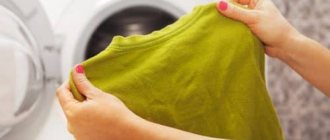At what temperature and how to wash wool?
So how to find a common language with woolen products? The first thing that any owner of such clothing thinks about is how to keep the shape of your favorite sweater after washing? What should I do to prevent the product from shrinking, stretching, or matting? In fact, you can do a lot of things. But all these rules are quite simple and easy to follow.
Paradoxically, it is better not to wash wool. Or rather, do this as rarely as possible - only when necessary to remove specific dirt or stains. In other cases, it is recommended to hang the item of clothing periodically (2-3 times a year) on the street or balcony for ventilation. Streams of fresh air are often enough to refresh the product and get rid of foreign odors.
But if washing is inevitable, you need to prepare for it first theoretically: learn a lot of subtleties. There are three main and most important ones that have the greatest impact on the shape of washed products:
- temperature and its invariability;
- drum speed for machine washing (friction and spin for hand washing);
- proper drying.
So, temperature. For demanding wool, it should not exceed 30-35 degrees, otherwise the product will inevitably shrink or stretch. But for high-quality washing of woolen items, following this rule alone is not enough. It is equally important that soaking, washing and rinsing take place at the same temperature. Yes, the value of 10 degrees does not exceed 35. But if you wash the item with warm water and then rinse it with cool water, the shrinkage will be much more obvious. Sometimes it’s not even shrinkage, but local deformation (only of the cuffs or just the armpits), and after this it can be problematic to restore the shape of the products.
Mechanical impact (friction, spin) is another primary evil for woolen products. At the same time, they risk not only sitting down or stretching, but also significantly matting or becoming covered in pellets. So no spinning when washing woolen clothes! A minimum of rubbing and washing, a minimum value of the drum speed of the machine - these are important subtleties on the way to the longevity of knitted items.
Neat dress and neat skirt
If you need to iron a dress or sundress, you need to start from the top. Iron the collar, rollout, shoulders and belt. It is important to iron the darts correctly: those on the chest are ironed down, and those that are vertical are ironed towards the middle. If marks are imprinted on the front side, carefully place the tip of the iron under the fabric and smooth the fabric.
The hem is ironed first across, then along, carefully straightening out all the folds. Do not stretch the fabric too much - it will become deformed and will sag. Many people are afraid of ironing a product with folds or pleats. In this case, some skill will really be required. It will be easier to deal with wrinkles if you fix them with large loose stitches before washing.
Products for hand and machine washing of wool
It is clear that products made from this material cannot be washed with anything: the capricious material is susceptible to the negative effects of unsuitable detergents. Woolen items can become rough, prickly, lose their original luster, get stains in the form of streaks of unwashed powder, and become matted.
If you plan to wash the item by hand, then rubbing the item with a piece of laundry soap is completely wrong. And it will be difficult to rinse out such foam, and the rubbed areas will fall off.
A more gentle option may be suitable here - shavings from baby soap. But first you need to make sure that the product is completely dissolved in the water, and then beat it well with your hands. This delicate thick foam can carefully and efficiently wash a knitted product. Another alternative is to use hair shampoo. After all, wool is also hair, but of animal origin. Therefore, natural shine and softness after such a product will be guaranteed.
For machine washing, there are special powders designed for wool. They must have a designation - intended for washing woolen products. However, liquid products are more delicate and effective. They are already in a dissolved state, wash well, soften the fibers, preventing matting and pilling, and are easily washed out.
Washing even with the most delicate wool detergent will not help make your favorite clothes truly soft if the water is hard. Therefore, the use of special softeners for hard water when washing woolen items is mandatory.
For bleaching, if the need arises, chlorine-containing substances cannot be used - they will destroy the delicate texture.
Advice
To bleach wool items, use regular table vinegar. It will not only make things whiter, but also soften the fibers and give them shine. Hydrogen peroxide is also suitable for these purposes.
Ironing items made from various fabrics
Items made of artificial and natural silk should be ironed from the wrong side with a not very hot iron. Silk sets, which are not recommended to be ironed on the front side, are ironed through thin paper, and a damp cloth is placed under the area being ironed.
Products made from woolen knitwear are ironed dry, but through damp cotton or linen fabric, to which the iron does not stick. The fabric you are ironing on should not be linty or have seams.
silk knitwear at all. It is enough to straighten them when half-dried, giving them the desired size and correct shape. If you still have to iron silk knitwear, this should be done with a not very hot iron from the wrong side or through a damp cloth that is not dried dry with an iron.
Do not forget that nylon fabrics and acetate silk products cannot be ironed with a hot iron!
How to wash and dry correctly?
Well, now – the basic “truths” of washing, as well as subsequent drying of wool. What and how to do - right?
- Excessive contact of the product with water should be avoided. Soaking and washing should not exceed an hour in total, otherwise the fibers will swell and lose elasticity. As a result, the canvas will stretch hopelessly.
- For this reason, woolen items should be washed in a washing machine, choosing only delicate modes, and spinning should be turned off completely.
- No aggressive effects are allowed during hand washing! The process should be reduced to delicate “mixing” of the product in a basin with a soap solution. Pressing, rubbing, twisting, crushing with force is the same as killing an expensive, beautiful thing. Loss of shape and pilling are guaranteed.
- Hand washing will require a lot of water because the fibers absorb it a lot.
- You need to rinse such things several times until the water becomes completely clear. Otherwise, there is a risk of not only making the clothes hard and creaking, but also giving them unsightly stains. In addition, many people are allergic to detergent residue on clothes.
- Clothes made from wool should not be wrung out. Therefore, after washing, things should be placed in a basin to allow the water to drain naturally.
- The next step is to carefully wrap the sweater several times alternately in large terry towels to allow them to absorb any remaining moisture.
- Such products need to be dried by carefully laying them out on a horizontal surface, ideally with air circulation from below (this can be a home dryer on which a terry towel is placed).
- High temperatures and dry air are two more enemies of wool. From them it very quickly becomes brittle and collapses. Therefore, drying on radiators or heaters is absolutely contraindicated: the temperature in tandem with dry air will do its destructive work quickly.
- Hanging on ropes or even hangers will also ruin a woolen item. Having absorbed a lot of water, it will stretch out catastrophically during drying.
Advice
Even if your clothes definitely don’t fade, you need to wash light and dark ones separately. Lint from one product can stick to the surface of another and ruin the entire painting. Correcting such an incident can be difficult.
Preparatory stage
Before you start ironing, you need to do a little preparatory work. It will take no more than ten minutes, but it will save a lot more time. First, study all the tags on things. Usually they indicate whether the product can be ironed at all, and if so, at what temperature, and whether steaming is allowed.
If the label is missing or the marks on it are no longer readable, the following information will help:
- Linen can be ironed at the highest temperatures - from 190 to 230 degrees.
- Cotton items will withstand temperatures up to 190 degrees, but if it is below 165 degrees, things will not be ironed properly.
- For wool, temperatures ranging from 140 to 165 degrees are recommended.
- Silk and other delicate fabrics should be ironed at a temperature of 115 to 140 degrees.
- Rayon and other synthetics will melt at temperatures above 115 degrees.
Now you need to prepare a convenient place for ironing. It is better to place the board near a window or under a lamp. Ideally, you should be on the right and the light source should be on the left. The cord should not lie on the board and interfere.
If you don’t have an ironing board, you can use a table, covering it with a blanket and a cotton diaper or an old sheet. You shouldn't iron on soft surfaces - it's simply ineffective.
What to do if a woolen item shrinks after washing?
Unfortunately, no one is immune from such a nuisance. Perhaps the owner “shrinked” the blouse out of ignorance, perhaps she missed something in the process of caring for the clothes. But now she faces a problem: how to stretch the woolen item back? There are ways to solve this issue, but their effectiveness will depend on the degree of shrinkage of the wool, its composition, knitting pattern, and other factors. Therefore, it is difficult to give a 100% guarantee.
So, you can try the following “recipes”.
- If the wool contains synthetics, you can stretch such shrunken clothes by soaking them for one and a half to two hours in a solution of cold water with hydrogen peroxide (about 2 tablespoons for every 10 liters of water). After removing excess water, the product must be laid out on a hard horizontal surface with a terry towel underneath. From time to time it is necessary to stretch the shrunken item, giving it the required shape.
- A 100% wool sweater that has shrunk after improper washing can be revived by laying it out damp on an ironing board with a terry towel that will not fade. Next, you need to iron the item through a white cloth or gauze, gently stretching it in the right places.
- You can use table vinegar for this purpose - you need to soak a sponge with it and treat the surface of the blouse, then lay the product on a flat surface, stretching it to the desired size, and leave it to dry.
- If you wash a woolen item with shampoo and then fix it on a horizontal surface in the desired condition with pins until it dries completely, you can also return the jumper to its lost size.
- Washing in the following solution can help: 5 liters of water, 3 tablespoons of ammonia, a spoonful of turpentine. The process is the same: soak the item for a couple of hours in this composition, rinse, fix, dry.
Caring for woolen clothing is a painstaking process that requires certain knowledge. But now that they have been received, it will be much easier to cope with the characteristics of the wool. This means that things made from it will faithfully serve their owners for the allotted time, without upsetting surprises such as shrinkage or stalling.
Basic rules on how to iron things
A stand for a hot iron can be an ordinary inverted porcelain saucer or a thick earthenware or ceramic tile. The iron cools down slower on them than on a metal stand. Keep in mind that the iron should be kept in a dry place and covered to prevent it from collecting dust. It is best to sew a special cover for the iron or, after it has cooled, put it in a plastic bag.
The degree of heating of an ordinary iron can be determined using a drop of water. If the drop lingers on the iron and evaporates slowly, this means that the iron is moderately hot. This iron can be used to iron small parts that require careful smoothing, silk and knitted items. A hot iron is used to iron sheets, duvet covers, terry towels and those clothes that require ironing from the wrong side or through a damp cloth.
The sole of the iron can be cleaned by running it over paper sprinkled with an even layer of table salt, to which paraffin shavings have been added. The iron should be heated slightly beforehand.
The most convenient is an electric iron with a thermostat that allows you to regulate the temperature necessary for ironing items made from various types of fabrics. When the iron is turned on, it quickly heats up to a temperature of 85-114 degrees, which is necessary for ironing products made of nylon, viscose and other artificial fibers. Using a thermostat, it can be switched to a higher temperature - 140 degrees - for ironing woolen fabrics, or to 165 degrees - for ironing cotton products, and, finally, to 190-230 degrees - for linen fabrics. To prevent the iron from overheating, it is equipped with an automatic device: upon reaching a certain temperature, the iron turns off.
The thermostat prevents the fabric you are ironing from scorching. In addition, this type of iron is very economical - they consume 20 percent less electricity than ordinary ones.
Typically, ironing begins with items that require a relatively low temperature (for example, handkerchiefs), and gradually moves from artificial fabrics to silk, wool, cotton and linen.
When placing the iron on the stand , make sure that it is in a vertical position. To protect the polished soleplate of the iron from damage, do not place the iron on a hard or uneven surface. Before and after use, the iron should be wiped with a soft, dry cloth.
An iron with an automatic humidifier and steamer makes ironing easier. The water supply in the reservoir inside the iron is enough to generate steam for half an hour of operation. Steam is released through special holes in the soleplate of the iron.
Some irons also have a lever to regulate the steam supply. When ironing, the iron with the humidifier should not be tilted downwards, as hot water may leak from the holes where steam is released.
Linen is usually ironed on the front side . Only items with embroidery (so that it stands out in relief) are ironed first from the wrong side and then from the front side. Before you start ironing, it is recommended to run the heated iron over a clean, dry cloth several times.
To prevent items from losing their shape after ironing, they should not be immediately hung in the closet.









